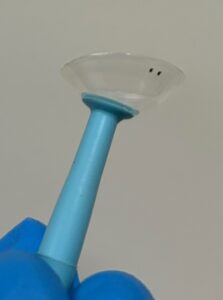Dot on Scleral Lens: What Does it Mean?
- April 19, 2023
If you wear scleral lenses, there is a fair chance that one of your lenses has a black dot on it. The black dot serves two potential functions. First, it can help you identify the right from left lens. Second, in some cases, the black dot is also designed to point a specific direction for optimal performance.
There is no hard and fast rule to the meaning of the black dot. The marking convention is different from one scleral lens design to another and there are over 50 proprietary scleral lens designs today. It can even differ within the same scleral lens design depending on the parameters your eye doctor prescribed. If you are wondering if there is any significance of the marking specific to your case, it is best to ask your doctor! That said, some general information is provided below.
Black Dot for the Right Lens
The most common convention shared by many scleral lens designs is that the right lens will have a single black dot. However, some lens designs will not have a dot on the right lens, and the “LaserFit” lens design has two black dots on the right lens by default. In some cases, your doctor may order your right and left lenses in different colors. In some cases, the lenses will have laser-etched inscriptions on the lens surface designating right from left. With at least one scleral lens design, a white dot is used instead for the right lens. Sometimes, the left lens will not have any black dot. In other cases, the left lens will have two black dots either side-by-side (Figure 1), or up-and-down.

Figure 1: Scleral lens dots, side-by-side.
The black dot is sometimes recessed under the lens surface. This is called a “drill dot” where the ink is submerged so that it does not wear off as easily. Over time, it is common for a regular dot to fade. These can be reapplied with a fine-tip Black Sharpie pen yourself.
Scleral Dot Orientation – Up, Down, or In Between?
For some lens designs like B+L Zenlens Scleral and EyePrintPRO, the dot position is classically downward. Yet for other lenses designs, like BostonSight SCLERAL, the dot position is classically upward. Even so, it does not always matter whether the lenses are applied with the dots going in their classic intended position. Some scleral lenses are rotationally symmetric such that the lens can spin on the eye with the dot position changing without any consequence to the eye health, comfort, and vision. Other scleral lenses are 180 degrees symmetric, meaning that the dot can position downward or upward without any consequence to lens performance. However, some highly customized scleral lenses are rotationally asymmetric so that dot position is important for optimal performance. As an example of highly customized scleral lenses, EyePrintPRO lenses individualized to each eye such that the lenses are intended for application with a proper orientation like a puzzle-piece fitting into its designated space. Highly customized sclera lenses may have peripheral edge recesses or lips on the edge of the lens that are designed to dodge obstacles on the eye surface. As you might expect, these edge recesses need to line up with the elevated surface obstacles.
For most scleral lens wearers, it is important to keep track of the right and left lenses. If lenses are switched, you may experience poor vision, reduced comfort, and be more prone to develop irritation or even an abrasion or infection. The black dot on the right scleral lens is a common way to help you distinguish between the right and left lenses. In addition, the black dot may identify the proper direction to apply the lenses on the eye. If you’re not sure of the significance of the black dot on your scleral lens, please ask your eye doctor.
ReVision Optometry is a referral-based practice in San Diego providing scleral contact lens services for patients with keratoconus and other complex eye conditions. To schedule an appointment, request your examination online or call our office at 619.299.6064.
